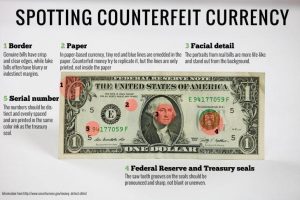Earlier Drug Bust Netted Counterfeit Cash
Sonora, CA — A Jamestown woman arrested this week for narcotics was also caught with a fake bill upon entering the Tuolumne County Jail prompting the sheriff’s department to issue a warning to the public.
There have already been five cases this month involving counterfeit $10 and $20 bills in the county. Several of those found with the fake cash on hand have been arrested, according to the sheriff’s department. Ironically, one person got caught with a bill while being booked into the county jail. As reported on Wednesday, 38-year-old Stephanie Martinez of Jamestown was arrested after a deputy pulled her over for speeding and failure to signal on Standard Road in Sonora on Tuesday evening. At the time of her arrest, Martinez offered up to the deputy two bags of methamphetamine, .35 grams of heroin, some marijuana and $84 in cash. However, the counterfeit cash was not found until her booking. Sgt. Andrea Benson states, “We did find Martinez in possession of a counterfeit $10 bill when she was brought into the jail. We do use counterfeit markers and it did prove to be fake bill.” Sgt. Benson adds that when Martinez was questioned about the bill “she stated she did not know it was a counterfeit bill.”
The sheriff’s department wants to warn the public and business owners about the phony cash. It has provided these tips to spot bogus money:
- Color shifting Ink- One of the first things to look for when checking to see whether or not a bill is authentic, is to see if the bill denomination on the bottom right hand corner has the right color shifting ink. All denominations of $5 or more have this security feature, going back to 1996. The 20 on the bottom right hand corner will have a copper color when you are looking straight at it. But, if you rotate the top of the bill down so that the bill looks flatter to your eye, it will turn more of a greenish On the new $100 bills, the inkwell also has color shifting ink, turning green and becoming extra visible when shifted to a flatter visual plane.
- Raised Printing- All authentic US reserve notes have raised printing. Many times, counterfeiters have a tough time duplicating this kind of printing method.
- Blurry Borders, Printing, or Text- If you notice significantly blurry borders, printing, or text, it is an automatic red flag. Authentic bills are extremely detailed, made using die-cut printing plates that are capable of impressively fine lines. Printers are rarely capable of the same level of detail. Take a close look, especially at the borders, to see if there is any blurring.
- Red and blue threads- If you take a close look at an authentic bill, you will see that there are small red and blue threads woven in and out within the fabric of the bill. Printers try to reproduce this effect by printing red and blue threads onto the bill in a similar pattern. But, a close look will often reveal that such printing is merely surface level, tipping you off to a counterfeit.
- Watermark- The next security feature to look for, is the characteristic watermark. In many of the new bills, the watermark is actually a replica of the face on the bill. In some, it is only an oval spot.
- Security Thread- The security thread is one of the most distinctive security indicators of an authentic bill. If you hold any bill up to the light, you will see a security strip on an authentic bill. It will have “USA” and the Bill’s denomination, aka “USA 20” running vertically on the bill. The ultimate test, is to put the bill under a uv or black light and make sure the bill glows the correct color. This extra security measure was originally added to provide a quick way for bar owners to check the legitimacy of a bill. Here are the location and colors of the security threads on different bills: * $5 – Right side. Glows blue under UV light * $10 – Right side. Glows orange under UV light * $20 – Far left hand side. Glows green under UV light * $50 – Right around the middle. Glows yellow Under UV light * $100 – On left side. Glows pink under UV light
Security Ribbon(On New $100 only)- The newly printed $100 has an extra security feature. There is a visible blue security ribbon down the right middle of the bill that is 3D. If you move it back and forth, you will actually see the number 100 and a variety of little bells will move from side-to-side as the bill shifts.
Serial Numbers should correspond to Printing Year/Series- The last thing to check on a bill, is to make sure the serial number matches the supposed series/run year printed on the bill. Each letter that starts a serial number for a bill corresponds to a specific year. Just be sure to check and make sure the series year stated is a correct match with the letter that starts the serial number, and vice versa Here are the letters and the corresponding years/runs they should match with. 1. E = 2004 2. G = 2004A 3. I = 2006 4. J = 2009 5. L =
Sgt. Benson notes that counterfeit detector pens can be purchased and used to help detect fake bills. If you receive any counterfeit money report it to local law enforcement immediately. Sgt. Benson adds, “If a person tries to pass a fraudulent bill at a business, we asked that the clerk hold the bill and call law enforcement. Don’t hand the bill back to the person. It will help in investigating the crime.”

